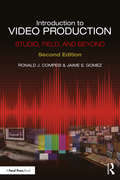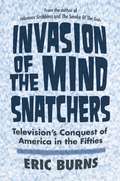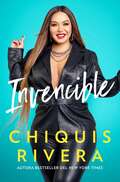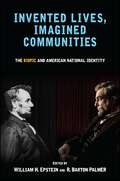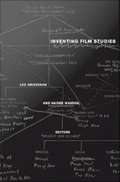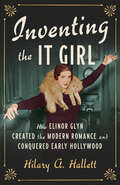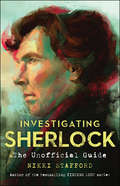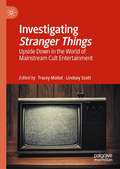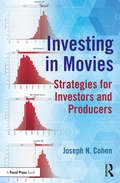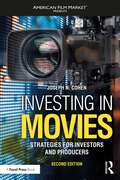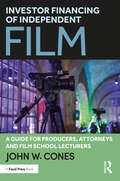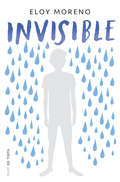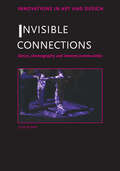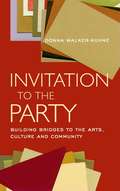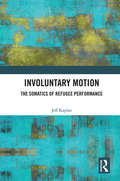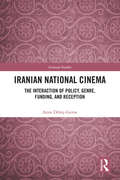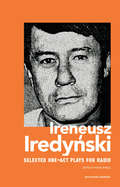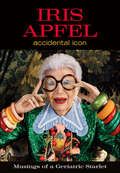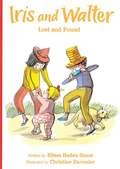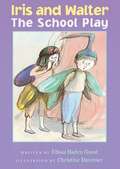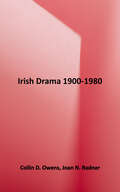- Table View
- List View
Introduction to Video Production: Studio, Field, and Beyond
by Ronald J. Compesi Jaime S. GomezWritten in a clear, non-technical manner, Introduction to Video Production focuses on the fundamental principles and aesthetics of video production and the technologies used in both studio and field environments. Ronald J. Compesi and Jaime S. Gomez cover each aspect of the process step by step, from preproduction to lighting, sound, directing, editing, graphics, and distribution. Taking into account the changes in workflow and production planning and distribution brought on by the advent of digital media, this second edition has been updated throughout to account for the increasing popularity of DSLR cameras, online distribution, the rise of portable cameras and mobile video, and much more. Key features include: a thorough overview of video production in studio and field environments without being overly technical, allowing students to get the "big picture" of production; coverage of new digital production, recording, and editing technologies; over 300 photos and line art illustrating aesthetic elements, technical issues, and production planning; key words identified in boldface throughout the text and reinforced in a comprehensive glossary of terms.
Invasion of the Mind Snatchers: Television's Conquest of America in the Fifties
by Eric BurnsWhen the first television was demonstrated in 1927, a headline in The New York Timesread, “Like a Photo Come to Life. ” It was a momentous occasion. But the power of television wasn’t fully harnessed until the 1950s, when the medium was, as Eric Burns says, “At its most preoccupying, its most life-altering. ” And Burns, a former NBC News correspondent who is an Emmy-winner for his broadcast writing,knows about the impact of television. Invasion of the Mind Snatcherschronicles the influence of television that was watched daily by the baby boomer generation. As kids became spellbound by Howdy Doodyand The Ed Sullivan Show,Burns reveals, they often acted out their favorite programs. Likewise, they purchased the merchandise being promoted by performers, and became fascinated by the personalities they saw on screen, often emulating their behavior. It was the first generation raised by TV and Burns looks at both the promise of broadcasting as espoused by the inventors, and how that promise was both redefined and lost by the corporations who helped to spread the technology. Yet Burns also contextualizes the social, cultural, and political events that helped shape the Fifties-from Sputnik and the Rosenberg trial to Senator Joseph McCarthy’s Red Scare. In doing so, he charts the effect of television on politics, religion, race, and sex, and how the medium provided a persuasive message to the young, impressionable viewers.
Invencible: Cómo descubrí mi fuerza a través del amor y la pérdida (Atria Espanol)
by Chiquis RiveraLatin Grammy Award–winning singer-songwriter and author of the New York Times bestseller Forgiveness returns with a new memoir that shares the triumphs, hardships, and lessons of life after her mother&’s, Jenni Rivera, death.Now available in Spanish. Bringing her signature warmth, humor, and positivity to the page, Chiquis Rivera picks up where her memoir Forgiveness left off. Reeling from her mother&’s tragic death, Chiquis finds herself at a major crossroads. As a new parent to her younger brother and sister, she struggles to balance her family&’s needs with her dreams of becoming a successful singer and entrepreneur. Stepping out of the shadow of her mother&’s legendary career and finding her own identity as a singer is challenging…but navigating unhealthy relationships proves to be even harder. When she meets and marries the person she believes is the man of her dreams, it seems like life is finally falling into place. But a dark secret unravels their relationship, and Chiquis emerges stronger as a single woman. In the end, nothing can keep Chiquis down. Her life philosophy says it all: &“Either I thrive or I learn.&” Filled with life-affirming revelations, Chiquis ultimately shares her greatest gift with her fans—the accessible lessons that have made her unstoppable.
Invented Lives, Imagined Communities: The Biopic and American National Identity (SUNY series, Horizons of Cinema)
by William H. Epstein; R. Barton PalmerBiopics—films that chronicle the lives of famous and notorious figures from our national history—have long been one of Hollywood's most popular and important genres, offering viewers various understandings of American national identity. Invented Lives, Imagined Communities provides the first full-length examination of US biopics, focusing on key releases in American cinema while treating recent developments in three fields: cinema studies, particularly the history of Hollywood; national identity studies dealing with the American experience; and scholarship devoted to modernity and postmodernity. Films discussed include Houdini, Patton, The Great White Hope, Bound for Glory, Ed Wood, Basquiat, Pollock, Sylvia, Kinsey, Fur, Milk, J. Edgar, and Lincoln, and the book pays special attention to the crucial generic plot along which biopics traverse and showcase American lives, even as they modify the various notions of the national character.
Inventing Film Studies
by Haidee Wasson Lee GrievesonInventing Film Studies offers original and provocative insights into the institutional and intellectual foundations of cinema studies. Many scholars have linked the origins of the discipline to late-1960s developments in the academy such as structuralist theory and student protest. Yet this collection reveals the broader material and institutional forces--both inside and outside of the university--that have long shaped the field. Beginning with the first investigations of cinema in the early twentieth century, this volume provides detailed examinations of the varied social, political, and intellectual milieus in which knowledge of cinema has been generated. The contributors explain how multiple instantiations of film study have had a tremendous influence on the methodologies, curricula, modes of publication, and professional organizations that now constitute the university-based discipline. Extending the historical insights into the present, contributors also consider the directions film study might take in changing technological and cultural environments. Inventing Film Studies shows how the study of cinema has developed in relation to a constellation of institutions, technologies, practices, individuals, films, books, government agencies, pedagogies, and theories. Contributors illuminate the connections between early cinema and the social sciences, between film programs and nation-building efforts, and between universities and U. S. avant-garde filmmakers. They analyze the evolution of film studies in relation to the Museum of Modern Art, the American Film Council movement of the 1940s and 1950s, the British Film Institute, influential journals, cinephilia, and technological innovations past and present. Taken together, the essays in this collection reveal the rich history and contemporary vitality of film studies. Contributors: Charles R. Acland, Mark Lynn Anderson, Mark Betz, Zo Druick, Lee Grieveson, Stephen Groening, Haden Guest, Amelie Hastie, Lynne Joyrich, Laura Mulvey, Dana Polan, D. N. Rodowick, Philip Rosen, Alison Trope, Haidee Wasson, Patricia White, Sharon Willis, Peter Wollen, Michael Zryd
Inventing the It Girl: How Elinor Glyn Created The Modern Romance And Conquered Early Hollywood
by Hilary A. HallettA Publishers Weekly Summer Reads Selection The modern romance novel is elevated to a subject of serious study in this addictively readable biography of pioneering celebrity author Elinor Glyn. Unlike typical romances, which end with wedding bells, Elinor Glyn’s (1864–1943) story really began after her marriage up the social ladder and into the English gentry class in 1892. Born in the Channel Islands, Elinor Sutherland, like most Victorian women, aspired only to a good match. But when her husband, Clayton Glyn, gambled their fortune away, she turned to her pen and boldly challenged the era’s sexually straightjacketed literary code with her notorious succes de scandale, Three Weeks (1907). An intensely erotic tale about an unhappily married woman’s sexual education of her young lover, the novel got Glyn banished from high society but went on to sell millions, revealing a deep yearning for a fuller account of sexual passion than permitted by the British aristocracy or the Anglo-American literary establishment. In elegant prose, Hilary A. Hallett traces Glyn’s meteoric rise from a depressed society darling to a world-renowned celebrity author who consorted with world leaders from St. Petersburg to Cairo to New York. After reporting from the trenches during World War I, the author was lured by American movie producers from Paris to Los Angeles for her remarkable third act. Weaving together years of deep archival research, Hallett movingly conveys how Glyn, more than any other individual during the Roaring Twenties, crafted early Hollywood’s glamorous romantic aesthetic. She taught the screen’s greatest leading men to make love in ways that set audiences aflame, and coined the term “It Girl,” which turned actress Clara Bow into the symbol of the first sexual revolution. With Inventing the It Girl, Hallett has done nothing less than elevate the origins of the modern romance genre to a subject of serious study. In doing so, she has also reclaimed the enormous influence of one of Anglo-America’s most significant cultural tastemakers while revealing Glyn’s life to have been as sensational as any of the characters she created on the page or screen. The result is a groundbreaking portrait of a courageous icon of independence who encouraged future generations to chase their desires wherever they might lead.
Inventory
by Chuck Klosterman A. V. ClubEach week, the writers of The A.V. Club issue a slightly slanted pop-culture list filled with challenging opinions (Is David Bowie's "Young Americans" nearly ruined by saxophone?) and fascinating facts. Exploring 24 great films too painful to watch twice, 14 tragic movie-masturbation scenes, 18 songs about crappy cities, and much more, Inventory combines a massive helping of new lists created especially for the book with a few favorites first seen at avclub.com and in the pages of The A.V. Club's sister publication, The Onion. But wait! There's more: John Hodgman offers a set of minutely detailed (and probably fictional) character actors. Patton Oswalt waxes ecstatic about the "quiet film revolutions" that changed cinema in small but exciting ways. Amy Sedaris lists 50 things that make her laugh. "Weird Al" Yankovic examines the noises of Mad magazine's Don Martin. Plus lists from Paul Thomas Anderson, Robert Ben Garant, Tom Lennon, Andrew W.K., Tim and Eric, Daniel Handler, and Zach Galifianakis -- and an epic foreword from essayist Chuck Klosterman.
Investigating Sherlock: The Unofficial Guide
by Nikki StaffordAn &“intelligent and lively&” companion to the hit BBC show starring Benedict Cumberbatch (Publishers Weekly). He&’s been depicted as a serious thinker, a master of deduction, a hopeless addict, and a bare-knuckle fighter. His companion is a bumbler, a sympathetic equal, someone helpless in the face of his friend&’s social inadequacies. Sherlock Holmes and John Watson remain the most-adapted fictional characters of all time. In 2010, when Benedict Cumberbatch and Martin Freeman stepped into the roles, they managed to meld many previous incarnations into two glorious performances. Over Sherlock&’s first three seasons, the Emmy Award–winning series has brought new life to stories over a century old and, with its Holmes and Watson for the twenty-first century, created a worldwide phenomenon. Investigating Sherlock examines each episode through in-depth and fun analysis, exploring the character development and cataloguing every subtle reference to the original stories. With biographies of Cumberbatch and Freeman, as well as Arthur Conan Doyle, Investigating Sherlock is great fun, and the ultimate guide to the great detective. &“One of the best-researched books out there on the BBC Show, with great interviews of the show&’s creators and primary actors.&” —GeekDad
Investigating Stranger Things: Upside Down in the World of Mainstream Cult Entertainment
by Tracey Mollet Lindsey ScottThis edited collection explores the narrative, genre, nostalgia and fandoms of the phenomenally successful Netflix original series, Stranger Things. The book brings together scholars in the fields of media, humanities, communications and cultural studies to consider the various ways in which the Duffer Brothers’ show both challenges and confirms pre-conceived notions of cult media. Through its three sections on texts, contexts and receptions, the collection examines all aspects of the series’ presence in popular culture, engaging in debates surrounding cult horror, teen drama, fan practices, and contemporary anxieties in the era of Trump. Its chapters seek to address relatively neglected areas of scholarship in the realm of cult media, such as set design, fashion, and the immersive Secret Cinema Experience. These discussions also serve to demonstrate how cult texts are facilitated by the new age of television, where notions of medium specificity are fundamentally transformed and streaming platforms open up shows to extensive analysis in the now mainstream world of cult entertainment.
Investing in Movies: Strategies for Investors and Producers
by Joseph N. CohenInvesting in Movies: Strategies for Investors and Producers is a useful guide for investors and producers looking for an analytical framework to assess the opportunities and pitfalls of film investments. The book traces macroeconomic trends and the globalization of the business, as well as the impact these have on potential returns. It offers a broad range of guidelines on how to source interesting projects and advice on what kinds of projects to avoid, as well as numerous ways to maximize risk-adjusted returns. While focusing primarily on investments in independent films, industry veteran and author Joseph Cohen also provides valuable insights into the studio and independent slate deals that have been marketed to the institutional investment community. Features of this book include: A guide to the minefield of film investing for the potential investor, giving students and aspiring professionals an insider perspective; A detailed explanation of the risk and rewards inherent in the film business and how to evaluate projects; Thorough coverage of the cast of characters that populate the film space, and advice on building relationships to optimize opportunities.
Investing in Movies: Strategies for Investors and Producers (American Film Market Presents)
by Joseph N. CohenIn this second edition of Investing in Movies, industry veteran Joseph N. Cohen provides investors and producers with an analytical framework to assess the opportunities and pitfalls of film investments. The book traces macroeconomic trends and the globalization of the business, including the rise of streamers, as well as the impact these have on potential returns. It offers a broad range of guidelines on how to source interesting projects and advice on what kinds of projects to avoid, as well as numerous ways to maximize risk-adjusted returns. While focusing primarily on investments in independent films, Cohen also provides valuable insights into the studio and independent slate deals that have been marketed to the institutional investment community. As well, this new edition has been updated to fully optimize the current film industry climate including brand new chapters on the Chinese film market, new media/streaming services, and the effects of COVID-19 on the global film market. Written in a detailed and approachable manner, this book is essential for students and aspiring professionals looking to gain an insider perspective against the minefield of film investing.
Investor Financing of Independent Film: A Guide for Producers, Attorneys and Film School Lecturers
by John W. ConesThis book explains how to comply with the federal and states securities regulations when seeking to raise money from private investors for the development, production and/or distribution of a feature or documentary film. Drawing from the experience and expertise of a securities and entertainment attorney who has worked with independent filmmakers for 30 plus years, this resource explores securities law compliance in order to help readers comply with the law and avoid criminal and civil liability, while successfully raising investor funds for their film projects. Readers will gain an understanding of why the securities laws apply to most investor financing transactions, what choices need to be made by the filmmaker, what information needs to be disclosed to prospective investors, how to comply with the SEC’s policy regarding financial projections, what is the appropriate investment vehicle for various forms of investor financing, what limitations are imposed on the use of finders and how to handle the required federal and state notice filings. It is an essential resource for any film student taking a film finance course (or a production course with a film finance component), as well as any independent film producers, entertainment/securities attorneys and film school instructors, who want to be informed about the legal and practical aspects of investor financing of independent films.
Invisible
by Eloy MorenoEmotiva, conmovedora, diferente... Invisible narra, a través de los ojos de un niño, una historia que podría ser la de cualquiera de nosotros. ¿Quién no ha deseado alguna vez ser invisible? ¿Quién no ha deseado alguna vez dejar de serlo? El problema es que nunca he llegado a controlar bien ese poder: A veces, cuando más ganas tenía de ser invisible, era cuando más gente me veía, y en cambio, cuando deseaba que todos me vieran, era cuando a mi cuerpo le daba por desaparecer.
Invisible Connections: Dance, Choreography and Internet Communities (Innovations In Art And Design Ser.)
by Sita PopatThe first and only book to focus on dance on the Internet, Sita Popat‘s fascinating Invisible Connections examines how Internet and communication technologies offer dance and theatre new platforms for creating and performing work, and how opportunities for remote interaction and collaboration are available on a scale never before imaginable.Drawing
Invisible Crises: What Conglomerate Control of Media Means for America and the World (Critical Studies in Communication and in the Cultural Industries)
by George GerbnerHidden from public sight and mind today are invisible crises that threaten our democracy and existence more than the crises we know about—or think we know about. These invisible crises include the promotion of practices that drug, hurt, poison, and kill thousands every day; cults of violence that desensitize, terrorize, and brutalize; the growing siege mentality of our cities; widening resource gaps and the most glaring inequalities in the industrial world; the costly neglect of vital institutions such as public education and the arts; and media-assisted make-believe image politics corrupting the electoral process.Deprived of sustained attention but bombarded by eruptions of surface consequences (often presented as unique events stripped of historical context), people ar bewildered, fearful, angry, and cynical.The contributors to this volume—exploring such unattended crises, analyzing why they are hidden, and focusing on the increasing concentration of culture-power that keeps them from view—maintain that a profound general crisis of social vision, public communication, and representative government underlies all of the invisible crises.
Invisible Storytellers: Voice-Over Narration in American Fiction Film
by Sarah KozloffSarah Kozloff examines and analyzes voice-over narration through examples from films and refutes the assumptions that words should only play a minimal role in film, that "showing" is superior to "telling," or that the technique is inescapably authoritarian.
Invitation to the Party
by Donna Walker-Kuhne George C. WolfeAcknowledged as the nation's foremost expert on audience development involving America's growing multicultural population by the Arts and Business Council, Donna Walker-Kuhne has now written the first book describing her strategies and methods to engage diverse communities as participants for arts and culture. By offering strategic collaborations and efforts to develop and sustain nontraditional audiences, this book will directly impact the stability and future of America's cultural and artistic landscape. Donna Walker-Kuhne has spent the last 20 years developing and refining these principles with such success as both the Broadway and national touring productions of Bring in 'Da Noise, Bring in 'Da Funk, as well as transforming the audiences at one of the U.S.'s most important and visible arts institutions, New York's Public Theater. This book is a practical and inspirational guide on ways to invite, engage and partner with culturally diverse communities, and how to enfranchise those communities into the fabric of arts and culture in the United States.Donna Walker-Kuhne is the president of Walker International Communications Group. From 1993 to 2002, she served as the marketing director for the Public Theater in New York, where she originated a range of audience-development activities for children, students and adults throughout New York City. Ms. Walker-Kuhne is an Adjunct Professor in marketing the arts at Fordham University, Brooklyn College and New York University. She was formerly marketing director for Dance Theatre of Harlem. Ms. Walker-Kuhne has given numerous workshops and presentations for arts groups throughout the U.S., including the Arts and Business Council, League of American Theaters and Producers, the Department of Cultural Affairs, and the National Endowment for Arts to name a few. She has been nominated for the Ford Foundation's 2001 Leadership for a Changing World Fellowship.
Involuntary Motion: The Somatics of Refugee Performance
by Jeff KaplanInvoluntary Motion contributes to the study of refugee flight by using movement as a lens to explore problems in refugee performance and understand the experience of bodies in motion. Drawing from Somatics, Movement Analysis, and dance praxis, the chapters explore forces that set bodies in motion; the spaces in which forced movement occurs; the movement of refugee identity arcs; the monstrosity of refugee performance; and the relationship between writing and body culture. How does forced movement impact identity? What are the philosophical implications of robbing agency over motion? What performances does involuntary motion necessitate? These questions are important as the world confronts the threat of a return of the horrors of the Twentieth Century. Bringing together debates in Migration Studies and Movement Studies, the book argues that refugees are akin to dancers performing on disappearing stages, not of their choosing. It will be of great interest to students and scholars of performance, dance and politics.
Iranian Cinema in a Global Context: Policy, Politics, and Form (Routledge Advances in Film Studies)
by Peter Decherney Blake AtwoodIranian films have been the subject of much critical and scholarly attention over the past several decades, and Iranian filmmakers are mainstays of international film festivals. Yet most of the attention has been focused on a small segment of Iranian film production: auteurist art cinema. Iranian Cinema in a Global Context, on the other hand, takes account of the wide range of Iranian cinema, from popular youth films to low budget underground films. The volume also reassesses the global circulation of Iranian art cinema, looking at its reception at international festivals, in university curricula, and at the Academy Awards. A final theme of the volume explores the intersection between politics and film, with essays on post-Khatami reform influences, representations of ineffective drug policies, and the representation of Jewish characters in Iranian film. Taken together, the essays in this volume present a new definition of the field of Iranian film studies, one that engages global media flows, transmedia interaction, and a heterogeneous Iranian national cinema.
Iranian National Cinema: The Interaction of Policy, Genre, Funding and Reception (Iranian Studies)
by Anne Demy-GeroeThis book examines transformations in the production and domestic and international reception of Iranian cinema between 2000 and 2013 through the intersection of the political markers – the presidential terms of Reformist president Mohammad Khatami and his successor, the conservative Mahmoud Ahmadinejad – and filmic markers, particularly Jafar Panahi’s The Circle (2000) and Asghar Farhadi’s About Elly (2009). Through extensive field and media research, the book considers the interaction of a range of factors including government policy, Iranian national cinema genres and categories, intended audience, funding source, and domestic and international reception, to demonstrate the interplay between filmmakers and the government over these two successive presidencies. While the impact of politics on Iranian filmmaking has been widely examined, this work argues for a more nuanced understanding of politics in and of the Iranian cinema than has generally been previously acknowledged. Drawing on both personal experience as a juror at the Fajr International Film festival and interviews with significant filmmakers, producers, actors and other industry insiders, including senior bureaucrats and politicians, the volume is a key resource for anyone interested in politics and Iranian cinema.
Ireneusz Iredynski: Selected One-Act Plays for Radio
by Kevin WindleThis vibrant anthology of radio plays features works by one of Poland's 'angry young men' playwrights. Ireneusz Iredynski made his début in literature as a Polish 'angry young man' in the late 1950s. He moved with great versatility from verse to stage plays, film-scripts and plays for radio. While some of the plays in this collection seem to present a bleak view of life, they show a gentler side of Iredynski. Here it is people's dreams rather than their worst nightmares that are explored. In these plays, situations are kept simple and the theatrical technique is spare and economical, but yet, the playwright demonstrates an unfailing theatrical flair and shows himself a master of dramatic tension and the final unexpected twist.
Iris Apfel: Accidental Icon
by Iris ApfelFrom the fashion icon, “a joyous, colorful collection of photographs; drawings; reflections; and personal mottos on marriage, business, fame and style” (Boca Raton Observer).The late great Iris Apfel was a woman who transcended time and trends—one of the most original and dynamic personalities in the worlds of fashion, textiles, and interior design. Written a few years before her passing at age 102, this is a lavishly illustrated memoir in which she shares her musings, anecdotes, and incomparable wisdom.As the cofounder with her husband of Old World Weavers, an international textile manufacturing company that specialized in reproducing antique fabrics, she served a prestigious clientele including Greta Garbo, Estee Lauder, Montgomery Clift, and Joan Rivers. She also acted as a restoration consultant and replicated fabric for the White House over nine presidential administrations. Iris’s worldwide travels and devotion to flea markets inspired her work and fueled her passion for collecting fashion and accessories. In 2005, she was the first living person who was not a designer to have her clothing and accessories exhibited at the Costume Institute at the Metropolitan Museum of Art, a blockbuster show that catapulted her to fame and a career as a model, muse, and collaborator for renowned brands from Citroen to Tag Heuer. In 2015, acclaimed director Albert Maysles released Iris, his Emmy Award-nominated documentary, to a global audience.This celebratory volume captures her unique joie de vivre and features 180 full-color and black-and-white photos and illustrations—presented in the same improvisational, multifaceted style that made Iris a much-loved legend. “It’s hard to resist this self-proclaimed ‘geriatric starlet.’ With her owlish glasses, loud prints and necklaces upon necklaces, even in her 90s, Apfel is a fashion icon who combines a memoir with photos of the vibrant contents of her closets.” —The New York Times Book Review
Iris and Walter: Lost and Found
by Elissa Haden Guest Christine DavenierWalter loves his grandmother's harmonica. But when he lets Iris borrow it the night before his grandmother comes to visit, something awful happens--it disappears! How will Iris break the news to Walter?
Iris and Walter: The School Play
by Elissa Haden Guest Christine DavenierIris and Walter can't wait for opening day of their first school play. Walter helps Iris make her costume. Iris helps Walter practice his lines. But when Iris wakes up sick on the morning of their debut, it looks like the curtain is going up on a big disappointment. . . .
Irish Drama, 1900-1980
by Coilin D. Owens Joan N. RadnerThis superb collection of eighteen plays has long been needed. It provides a sound and solid introduction to the rich field of modern Irish drama and should be as delightful to the private reader as it will be useful for university classes. The Journal of Irish Literature Contents: Spreading the News and The Gaol Gate - Lady Gregory; On Baile's Strand and the Only Jealousy of Emer -W.B. Yeats; The Land -Padraic Colum; The Playboy of the Western World -J.M. Synge; Maurice Harr -T. C. Murray; The Magic Glasses -George Fitzmaurice; Juno and the Paycock -Sean O'Casey; The Big House -Lennox Robinson; The Old Lady Says "No!" -Denis Johnston; As the Crow Flies -Austin Clarke; The Paddy Pedlar -M. J. Malloy; The Vision of Mac Conglinne -Padraic Fallon; The Quare Fellow -Brendan Behan; All that Fall -Samuel Becket; Da -Hugh Leonard; Translations -Brian Friel
